A bit of history and context
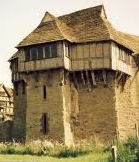 Traditional timber framing the way we do it today really seems to have its roots at the beginning of the medieval period. Many elements hark back to earlier times, the mortice and tenon and the king post truss were used extensively by the Romans for example, but the full vocabulary of styles and details, and the particular methods that we still employ today, all came together in the period following the Norman conquest of Britain.
Traditional timber framing the way we do it today really seems to have its roots at the beginning of the medieval period. Many elements hark back to earlier times, the mortice and tenon and the king post truss were used extensively by the Romans for example, but the full vocabulary of styles and details, and the particular methods that we still employ today, all came together in the period following the Norman conquest of Britain.
In the subsequent half century the biggest and the most wonderfully and perfectly framed structures were built, these being the ones that most framers in our times try to emulate or match if they can! This is the period when the majority of the most iconic frames were built, mainly out of oak, many surviving to this day in England and Wales, but not in Scotland unfortunately (more on this below).
Throughout the middle ages timber frames were used for both high status and low sta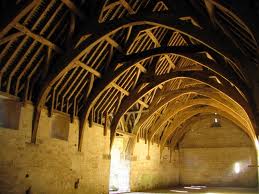 tus buildings of all kinds. from royal palaces and churches to barns and farm houses. Wherever it was used timber was regarded as a status symbol, the more you had in your building the more the Joneses would be envious. The timber structures them selves were celebrated and the master carpenters who built them became famed for their creativity in designing beautiful buildings. In the latter part of the middle ages in England and Wales, and to some extent in Scotland, a particular "gothic" style reached its height, characterized by curved timbers, especially braces, usually made from flat rather than square sections. Some of the loveliest designs have been engendered by this form of framing.
tus buildings of all kinds. from royal palaces and churches to barns and farm houses. Wherever it was used timber was regarded as a status symbol, the more you had in your building the more the Joneses would be envious. The timber structures them selves were celebrated and the master carpenters who built them became famed for their creativity in designing beautiful buildings. In the latter part of the middle ages in England and Wales, and to some extent in Scotland, a particular "gothic" style reached its height, characterized by curved timbers, especially braces, usually made from flat rather than square sections. Some of the loveliest designs have been engendered by this form of framing.
In the seventeenth and eighteenth centuries timber became more expensive due to the increase in iron smelting and ship building and other competition for the raw material. Coupled with the increase in masonry and brick building this spelled the end of the heyday of framing, although the tradition continued in altered forms for a good while longer. And as time went by changes in the social and economic
landscape brought in new trends and caused others to be abandoned. For
example the resurgence, in the eighteenth century, of the king-post truss in a new more slender form, was probably the result of the gradual replacement of native timbers (now scarcer) with Baltic softwoods, and the increasing availability of metal strapping and fasteners. By this time the location of the timber frame in the hierarchy of desirability had fallen to more of a utilitarian position. Richard Harris, one of our foremost timber frame historians, puts it like this: "Timber framing had ceased to be architecture and had become simply an element of structure." But this sad state of affairs is now being reversed in a revival of the craft.
In the 1970's and 80's after a long period where no traditional framing had been practiced at all, a few intrepid individuals began to relearn the skills and techniques used by the past masters, eventually forming small companies which specialised in the conservation of old timber frames and also building new houses and other structures out of green wood. People allover the country were starting to appreciate the beauty of an oak frame. In more recent years this resurgence of framing has mushroomed into quite a large industry, 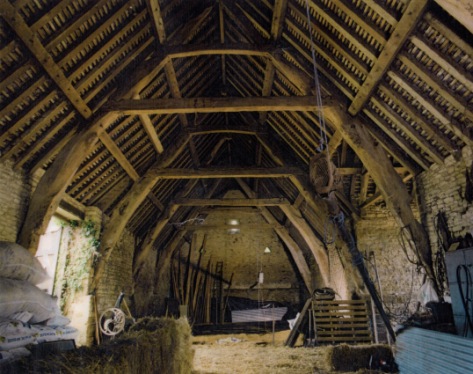 fuelled by many television appearances on Grand Designs and other programmes, and by a strong tendency for self-builders to choose a green timber frame, which has resulted in self-build magazines featuring the building method often. A more generalised tendency for people planning a new home to want natural, honest materials has also brought attention to green oak as have its superlative green (ecological) credentials (see sustainability sub-page).
fuelled by many television appearances on Grand Designs and other programmes, and by a strong tendency for self-builders to choose a green timber frame, which has resulted in self-build magazines featuring the building method often. A more generalised tendency for people planning a new home to want natural, honest materials has also brought attention to green oak as have its superlative green (ecological) credentials (see sustainability sub-page).
There is a very rich palette of regional and temporal variation within the European tradition and nowhere more so than in Britain. We enjoy a fantastic array of frame designs with overlapping style regions causing the pattern to become complex and multi-layered. There are some more examples on the Frame Types page, but this is only a small proportion of the possible configurations, because carpenters throughout the ages have had to design structures to meet the differing conditions of every build and location, not to speak of the clients desire for grandeur and decoration, or conversely budgetary constraints.
The Scottish Framing Vernacular: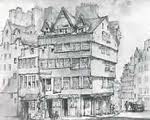
There was a very strong timber framing tradition that flourished in Scotland right up to the 1700’s. Much as in the rest of Britain, this tradition began suffering a decline after this time, and eventually completely disappeared, but here much of the evidence for it also disappeared. Most of the framing record was wiped out during the 18th century, in the towns
by a mixture of fash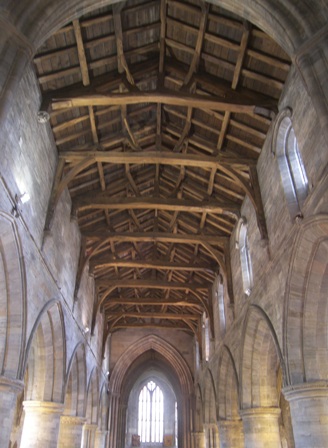 ion and local legislation, and in the country by a wave of well-meaning destruction during the 'improvements'
period when low status vernacular buildings were upgraded en masse by enthusiastic estates. Since almost all of the property in Scotland was estate owned not many timber framed buildings escaped demolition and those that did would have been regarded as coming from an older, less desirable tradition. Most of them did not last long. The result is not only that most people don’t realise there was such a tradition, but that most of the framing companies who are part of the recent resurgence of this building method here in Scotland, do not have much concept of how it differed from more well known foreign models which still survive.
ion and local legislation, and in the country by a wave of well-meaning destruction during the 'improvements'
period when low status vernacular buildings were upgraded en masse by enthusiastic estates. Since almost all of the property in Scotland was estate owned not many timber framed buildings escaped demolition and those that did would have been regarded as coming from an older, less desirable tradition. Most of them did not last long. The result is not only that most people don’t realise there was such a tradition, but that most of the framing companies who are part of the recent resurgence of this building method here in Scotland, do not have much concept of how it differed from more well known foreign models which still survive.
An additional contributor to this state of affairs is that, for reasons to do with the late arrival of this resurgence here, most of the oak framers currently in Scotland have come from outside Scotland (as have I) , or have been trained by English, French, Canadian, German or American companies. The result is that the style of their designs tend to be based mostly on these traditions, and are little affected by the relatively obscure native style, which in many ways seems to have more in common with Flemish and early Norman styles.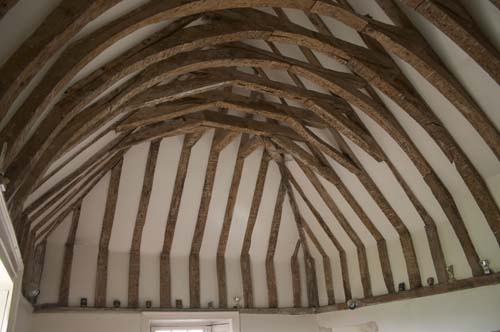
It would be good if the Scottish vernacular timber framing style could be resurrected, even if only in the occasional building, by piecing together the scant evidence that we have and trying to unearth more, and that then, should the client require it, it could be used to inform design decisions that are going on in the present day.
These frame types are not necessarily unique since Scotland shares frame design influences with many parts of Britain and Europe. For example, platform framing with the Low Countries and northern France, jointed crucks with the Celtic Fringe of western Britain, straight square section braces with mainland Europe, but also curved braces and brackets with gothic southern England (as seen in this print of John Knox's Hou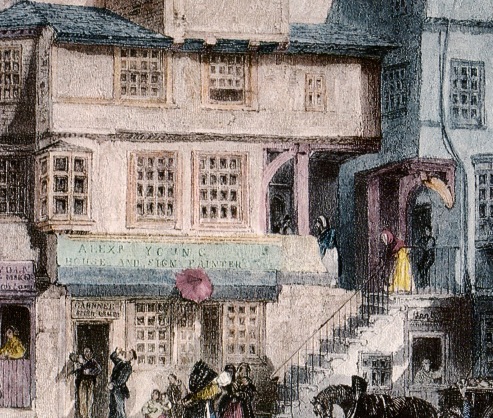 se in Edinburgh, left).
se in Edinburgh, left).
I feel I can now offer a fairly well researched range of regional Scottish frame details and frame types to fit the structural needs of any project, should the client be keen on the idea. This may be a service unique to J. Rose Carpentry.
There is no reason why this kind of thing could not be incorporated into contemporary designs as well, since old and new design elements often show each other off to great effect.
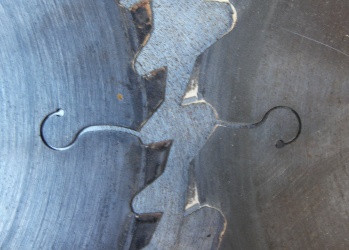 J. Rose Carpentry
J. Rose Carpentry